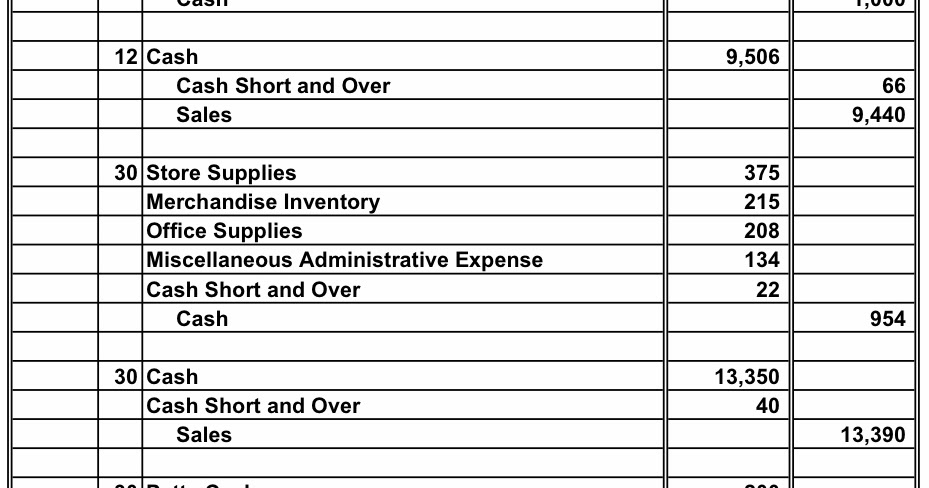
Generally, the amounts in the account Cash Short and Over are so small that the account balance will be included with other insignificant amounts reported on the income statement as Other Expenses. As mentioned, petty cash can make things nice and convenient but does carry certain risks. If you follow the petty cash account cash short and over is a permanent account. some best practices, you can reduce the risks that come with petty cash, and protect yourself and your employees. Cash Over and Short account is also used for Petty Cash overages and shortages. While all expenses need to be recorded, it allows for a simplified system of tracking small costs.
Related AccountingTools Courses
As you optimize your financial processes, consider how alternative financing solutions can further enhance your business’s financial flexibility. Remember, the key to success with PC lies in striking the right balance between convenience and control. It’s a good practice to start with a conservative amount and adjust based on actual usage over time. For very small businesses, this additional task might outweigh the benefits. This can aid in more accurate budgeting and cashflow forecasting, which is crucial for SMBs operating with tight margins.
Petty Cash Management: Efficient Tips for Small Businesses
A series of cash overs and shorts may be a sign of theft or other problems in the company. In modern business practices, it has evolved into a structured system for handling minor expenses efficiently. It’s typically managed through a petty cash fund, a fixed amount of money set aside for these small purchases. In the balance sheet, petty cash is considered a current asset, as it is expected to be used within a short period of time. The ending balance of the petty cash account should be reported under the “current assets” section.

How confident are you in your long term financial plan?
This voucher indicates the purpose of the expenditure, the date, and the name of the person receiving the cash. To create a petty cash fund, a check is written to cash for a set amount such as $75 or $100. These expenditures include items such as postage, delivery expense, and minor office supplies (e.g., coffee). Although it would be preferable if all disbursements were made by check and all receipts were deposited intact, most firms usually maintain a small amount of cash on hand for miscellaneous expenditures. For example, at the end of the month, the receptionist of the company ABC needs to request reimbursement to refill the petty cash fund of $100. After a designated interval—usually, the same time each month or week—it’s time to reconcile or balance the petty fund account.
Ask Any Financial Question
- Any costs resulting from theft, such as door or lock repair, can also be recorded as theft expense.
- In the world of business finance, petty cash might seem like a small change, but it can make a big difference in your day-to-day operations.
- In accounting, cash over and short journal entry is usually made when the company replenishes its petty cash fund.
- Instead, designate one employee to be responsible for the petty cash fund.
- The cashier creates a new check in the amount of the receipts, and swaps the check for the receipts.
For the past 52 years, Harold Averkamp (CPA, MBA) hasworked as an accounting supervisor, manager, consultant, university instructor, and innovator in teaching accounting online. For the past 52 years, Harold Averkamp (CPA, MBA) has worked as an accounting supervisor, manager, consultant, university instructor, and innovator in teaching accounting online.
In accounting software, this entry will add the petty cash check to your print checks list. Using columnar paper with a debit, credit and balance column, enter the amount of petty cash in the debit column. Debit your cash short and over account in your journal entry by the amount of cash short. Alternatively, credit your cash short and over account by the amount of cash over. Subtract the amount by which you need to replenish the account from the total amount of your vouchers.
For example, fraud situations may be traced back to the people directly responsible for a cash register or petty cash box. Each time you tap into a petty cash fund—that is, take money out—a slip or voucher should be filled out. This acts as a receipt, logging the amount of the withdrawal, the date, the purpose, and other details. Increasingly, these slips are electronic ones, entered in a digital spreadsheet or ledger.
Keep petty cash on hand in your business to cover small unexpected expenses. These expenses can include paying postage, tipping delivery people, purchasing supplies, buying gifts and more. The accounts involved in journalizing petty cash are petty cash, cash and cash short & over. Record petty cash shortages and overages in the cash short & over account. In this case one balance sheet asset (cash), has been increased by 1,414 when the cash is banked. The physical transactions for petty cash, cash short and over need recording with the appropriate journal entries.
Petty cash is recorded in accounting by maintaining a petty cash log that includes the date, amount, purpose, and recipient of each transaction. The petty cash account is typically replenished periodically by recording a journal entry that debits the individual expense accounts and credits the petty cash account. Additionally, this account is usually included in the other expenses or other revenues when we prepare the income statement at the end of the accounting period. Sometimes, the petty cash custodian makes errors in making change from the fund or doesn’t receive correct amounts back from users. These errors cause the cash in the fund to be more or less than the amount of the fund less the total vouchers. When the fund is replenished, the credit to Cash is for the difference between the established amount and the actual cash in the fund.
